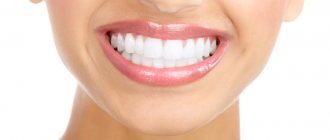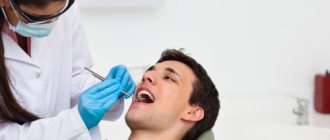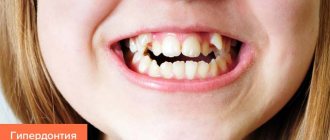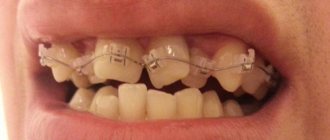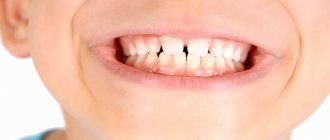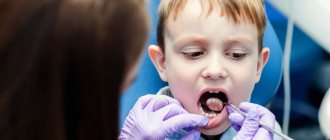Polyodontia (hyperodontia, hyperdentia) is the appearance of supernumerary teeth. Normally, an adult has 28-32 teeth (including wisdom teeth); with polyodontia, an indefinite number of extra teeth appear. About 2% of the world's population suffers from the pathology.
There are no methods to prevent the development of polyodontia, but it is possible to reduce the number of complications caused by the disease. Therefore, it is necessary to be attentive to your health and undergo a preventive examination with a dentist twice a year. If you suspect that an extra tooth has appeared in your mouth, you should immediately consult a doctor. Particular responsibility lies with parents, since children are not able to independently monitor the health of their teeth.
Concept and signs of supernumerary teeth
Hyperdentia (hyperdentia from hyper and lat. dens, dentis tooth) is an anomaly in the number of teeth.
Up to a certain age, children should ideally have twenty milk teeth, which are gradually replaced by permanent ones, and there are 32 of them. With hyperdontia, these numbers shift by one or more positions in a larger direction, since in this case there are one or several more tooth buds than normal.
Supernumerary teeth, as a rule, erupt after the main teeth, but there are exceptions when the supernumerary has erupted and taken the place where a normal tooth should be. As a result, teeth shift and bite changes. Only in rare cases does hyperdontia make itself felt during the period of milk eruption. Most often, this anomaly occurs among men, which accounts for about 65% of the total number of such cases.
In 15% of cases of this anomalous phenomenon, more than two supernumerary teeth erupt on the gum or palate. The most common phenomenon among hyperdontic anomalies is the eruption of supernumerary teeth in the area of the lateral incisors on the upper jaw, and less often on the lower jaw. Such teeth may differ from normal ones in shape, structure, color, which indicates their abnormal origin.
What does the dental formula look like in a medical record?
The dental formula of an adult, as well as a child, in the medical record of a dental patient looks in the form of a schematic table (Fig. 5), which will reflect only the serial numbers of permanent or baby teeth.
Directly in this formula, the doctor will mark the missing teeth (in this case, the number is crossed out with a cross), which teeth are affected by caries, pulpitis or periodontitis, as well as which of them have crowns or bridges. Dental formula in the form of a table in the medical record –
Hyperdontia in an adult
In adults, hyperdontia is much more common than in children. Additional teeth are mainly located in the palate or on the gums, which is unnatural and contrary to the norm. The eruption of an “extra” tooth can cause the following symptoms:
- Impaired diction. The person begins to burr and vaguely pronounce some sounds and sound combinations.
- A feeling of discomfort caused by the abnormal position of supernumerary teeth. Such teeth provoke curvature of the dentition.
- Malocclusion. This problem entails a number of dental diseases, such as pathological tooth wear, impaired diction and others.
- Damage to the oral mucosa with subsequent inflammation;
- Impaired chewing function, which leads to gastrointestinal problems.
This type of anomaly often causes nervous breakdowns and mental disorders. Due to the displacement of the dentition, healthy teeth lose their strength and begin to loosen under the pressure of the growing supernumerary rudiment. The jawbone swells, which leads to pain. Constant aching pain leads to irritability, apathy and deterioration in general well-being.
Frequently associated pathologies
Against the background of hyperdontia, curvature of correctly growing units and their roots, deformation of the entire row, and the appearance of large threes and diastemas with an open or deep bite are often observed. As mentioned above, in adults, supernumerary elements are most often accompanied by dystopia and retention - let’s look at these phenomena in a little more detail.
Dystoped elements
This anomaly involves the curvature or incorrect position of individual units. It is observed in adults, when extra elements grow in an already formed bite. The pathology has the following characteristic features:
- appearance of teeth on the hard palate or lingual areas,
- their incorrect rotation, tilt and severe curvature,
- abnormal shape, often cone-shaped.
Dystopic teeth occur when the bite is already formed.
The gums and the mucous membrane become inflamed, and on x-rays one can sometimes observe clear signs of deformation of the jaw bone and the root system of the supernumerary elements. It should be noted that in addition to functional disorders, patients face serious psychological discomfort. Its prolonged influence leads to disruptions in the functioning of the nervous, digestive and endocrine systems.
Retention as one of the common accompanying phenomena
This term implies partial eruption of crowns, when they remain half or even completely in the bone tissue. Often the patient does not experience any discomfort, and may not even be aware of the presence of this pathology. However, subsequently this phenomenon leads to the development of the following symptoms:
- swelling and redness of the mucous membrane in the area of the defect,
- loosening of apparently healthy incisors and molars,
- the appearance of subcutaneous protrusions when the causative element is localized near the edge of the jaw,
- aching pain for no apparent reason.
Teeth may not completely erupt.
Particularly difficult are cases when excess impacted elements appear near wisdom teeth, which is why they cannot erupt freely. This situation is fraught with the development of severe inflammation with suppuration, curvature of the entire row and damage to the roots of neighboring healthy molars.
Hyperdontia in children
Sometimes the eruption of extra abnormal teeth in children is almost asymptomatic. The only sign of polyodontia is the number of teeth erupted, which exceeds a certain norm for a particular age. Most often, this anomaly is accompanied by a number of unpleasant symptoms, which should cause concern among parents and become a reason to consult a dentist.
Signs of polyodontia in children:
- a rapid increase in temperature, which is difficult to bring down and lasts from one to several days;
- a strong aching or throbbing pain is felt at the site where the irregular tooth erupts;
- there is a feeling of discomfort when talking, eating, drinking;
- a slight swelling of the cheek and even the wing of the nose is noticeable on the side where the extra element erupts;
- due to excessive salivation as a reaction to an irritating factor, a wet cough and difficulty breathing may occur;
- gastrointestinal disorder as another reaction of the body to the inflammatory process and high temperature.
The symptoms of the eruption of supernumerary teeth in children are similar to those observed when the first milk teeth appear, only in this case the situation is a little complicated by the fact that the germination of an extra tooth is not something normal and inherent in nature. This makes it more difficult for the child to tolerate this phenomenon than the eruption of healthy baby teeth.
Is it necessary to remove an impacted tooth?
A tooth that has not fully erupted or remains under the gum may not make itself felt for a long time. Only x-rays will show that it is positioned incorrectly. But is it worth having surgery if you don’t experience any discomfort? Dentists unequivocally say yes!
Even if the tooth is not causing concern, it continues to grow under the gum and will eventually begin to dislodge its neighbors. With partial teething, hygiene becomes more difficult - it is almost impossible to reach some areas with a brush, which is why bacteria accumulate on them and caries develops. By the way, it is also almost impossible to cure it qualitatively.
Over time, the infection can spread throughout the entire oral cavity and even move higher - to the pharynx and ear canal, causing inflammatory processes in them.
By the way, the sooner an impacted tooth is detected and removed, the easier the operation itself will be. In addition, surgery is always easier to tolerate if there is no acute inflammation at the time. If you find a tooth on an x-ray that is growing incorrectly and is unlikely to ever fully erupt, it is better to immediately contact a surgeon.
Causes of jaw abnormalities
To date, doctors have not reached a unanimous opinion about the causes of such an anomaly as hyperdontia. There are different hypotheses about this:
- Atavism. Historians have proven that primitive people, due to the way of life they led, naturally had 36 tooth primordia. The results of studies of the remains of those times indicate that people had six incisors on the upper and lower jaws. Therefore, polyodontia is a kind of genetic anomaly that makes itself felt after thousands of years;
- Many doctors are inclined to the theory that one embryo splits into several in the womb, when, in fact, they begin to form. This theory also states that an anomaly can develop throughout pregnancy if it was quite severe, the woman suffered serious illnesses or led an unhealthy lifestyle (bad habits, drugs, alcohol and others);
To date, research continues to establish the true cause of hyperdontia. Based on these data, modern doctors are more inclined to the second version than to the first.
Stages of removing an impacted tooth
The difficulty of removing an impacted tooth is determined by the degree of its location and immersion (a distinction is made between bone immersion, in which the tooth has not even emerged from the jawbone, and tissue immersion, in which the tooth is located in the gum, but has not erupted outward). Upper impacted teeth are much easier to remove than lower teeth due to their physiological characteristics.
Removal of an impacted lower tooth is carried out in several stages:
- diagnostics. X-rays are taken to determine the degree of immersion of the tooth, the number of its roots and their location relative to each other and the roots of neighboring teeth.
- anesthesia. We use high-quality drugs and syringes with thin needles for local anesthesia
- removal of an impacted tooth. To do this, the dental surgeon, using special tools and equipment, opens the gum and, if necessary, the jaw, extracts the entire tooth or splits it into several parts and removes them one by one. Be sure to put a medicine into the resulting hole that relieves inflammation. If a large hole forms, sutures may be placed
- A repeat x-ray taken to ensure that all parts of the tooth have been removed.
Recommendations after removal
Removing an impacted wisdom tooth is a complex dental operation, so certain recommendations must be followed after the procedure:
- do not consume food or drink for at least two hours
- Apply ice to the cheek on the removal side during the day.
- do not drink hot drinks or food for the first three days after removal
- do not visit the bathhouse, sauna, reduce physical activity
- do not pick at the hole with sharp objects and do not “lick” it with your tongue
- maintain oral hygiene, brush your teeth carefully
- If your doctor has prescribed medications, you should definitely take them
- rinse your mouth after eating with boiled water
- try to chew with the opposite side of the jaw.
Cost of removing an impacted tooth in St. Petersburg:
An impacted tooth is quite difficult to remove. This is a full-fledged dental operation, which is performed under serious anesthesia and only by an experienced dental surgeon. For the removal of an impacted tooth, the price depends on many factors - the complexity of the removal, the determined depth of immersion and location of the impacted tooth, the chosen anesthesia, the time of the operation, etc.
Removal cost
| Local injection anesthesia (as a separate service) | 840 ₽ |
| Removal of a tooth (roots) with preliminary dissection of the soft tissues around the tooth (roots) | 4 400 ₽ |
| Removal of an impacted tooth with preliminary dissection of the surrounding soft and hard tissues | 6 300 ₽ |
| Removal of an impacted tooth | 4 210 ₽ |
| Surgical exposure of an impacted tooth | 1 540 ₽ |
Types of hyperdontia
Depending on the location of the supernumerary teeth, several types of polyodontia are distinguished:
- Conical or awl-shaped tooth . In this case, excess rudiments erupt between the upper central and lateral incisors. The name of the anomaly comes from the peculiar shape of the supernumerary tooth, which looks like an awl. This form of hyperdontia is dangerous because the sharp end of the tooth often injures the mucous membrane, which is why an inflammatory process develops when an infection gets there.
- Additional molars . Such teeth grow between the main molars, displacing the dentition from the correct position.
- Extra fangs . This type of anomaly is typical for the upper jaw.
- Supernumerary premolars . These additional teeth are located on the lower jaw. Each type of anomaly looks different depending on where and how the extra teeth are located. These differences can be clearly seen in the photo.
Diagnostic methods
Diagnosis of polyodontia is carried out exclusively by a specialized doctor - an orthodontist, who conducts a preliminary examination of the oral cavity and dentition, refers the patient to x-rays (orthopantomography) and analysis of anthropometric casts of teeth made of plaster. Such models are made for a more detailed study of a specific anomalous phenomenon, on the basis of which a diagnosis is then made and treatment is prescribed.
Table of normal human teeth. Deviation from the norm - polyodontia
When examining plaster models made on the basis of dental casts, the doctor measures the size of the teeth, and then analyzes the data obtained based on a special table by Wetzel and Ustimenko. The length of each row of teeth must be measured. This indicator may fluctuate depending on such characteristic individual characteristics of a person as crowding of teeth or the presence of large gaps between them. In the first case, the length will be less than normal, and in the second, a little longer. To diagnose asymmetry, the distance from the midline of the palate (or hyoid frenulum) to the far point of the dentition in one direction or the other is determined.
What to do?
The presence of supernumerary teeth is an abnormal phenomenon, so the issue of eliminating this problem must be resolved. How, this is another question, to give an unambiguous answer to which is impossible. As a rule, there can be several ways to solve a problem. The choice of treatment method depends on where the extra tooth is located, what shape it is, and what stage of eruption it is at.
Facilitating teething in baby
Drug treatment allows you to relieve unpleasant and painful symptoms during the eruption of excess buds. This option is the only one for children with baby teeth if the tooth is only at the eruption stage. When it finally germinates, it will be necessary to use more radical methods. The dentist prescribes medications that will help relieve pain, reduce fever and stop the inflammatory process in the soft tissues of the gums.
Simple tooth extraction
Surgery. This method is the fastest and most effective, since removing an extra tooth easily solves the problem and relieves a person from unpleasant sensations and discomfort. This treatment method is used when there is too little space in the dentition for an extra tooth or there is no space at all. Most often, supernumerary teeth are removed when there is crowding of the teeth. To free up some space in the dentition, the wisdom teeth are removed first, and if this was not enough, the premolars are also removed.
Braces and other orthodontic treatment methods
Orthodontic treatment is a method that involves correcting the bite, straightening the teeth, etc. The result is achieved by installing braces or other orthodontic structures that allow you to straighten crooked teeth and return them to their place, where they should be. The duration of wearing braces depends on many factors:
- the age of the patient (children have their own specifics);
- complexity of the situation;
- locations of supernumerary teeth and others.
At the first and second stages of the disease, the doctor may decide to install special expansion plates or aligners. Can also apply the separation method.
Consequences of poor quality treatment
If the treatment is not well-carried out, impacted teeth will continue to interfere with the normal development of the bite and dentition, which causes a violation of chewing ability, leading to a number of problems with the gastrointestinal tract, and impaired diction, which negatively affects pronunciation and pronunciation. Also, after unsuccessful treatment, healthy teeth that are located next to the additional one may begin to deteriorate.
Preventive measures
The essence of preventing dental anomalies is to eliminate the possible causes of their appearance even at the stage of formation of rudiments, that is, all responsibility for possible dental anomalies depends entirely on the child’s mother.
To prevent this unpleasant phenomenon, you need to eat right, food should be balanced and healthy. It is important to give up bad habits and follow your doctor’s recommendations. When the baby is small, you need to make sure that he does not suck his finger or pacifier for more than a year and regularly take him for examinations to the dentist for timely detection and elimination of dental problems. Moscow metro station Zvezdnaya, Danube Avenue, 23
What treatment is required
Treatment of hyperdontia can be carried out in several directions. The choice of a specific method or their combination depends on the patient’s age and the clinical picture as a whole. For children, therapy usually involves eliminating symptoms and correcting pathology. Severe cases in adults may require surgery.
How to relieve teething symptoms
If the child is still very small, under the age of 3 years, he is prescribed antipyretic drugs to normalize the condition and relieve acute symptoms of teething. For very young infants, products in the form of suppositories or suspensions are recommended. To relieve pain, medications with analgesic and anti-inflammatory effects, such as Kalgel, Soloxeril or Dentinox, can also be prescribed. Until a certain age, serious interventions are contraindicated, so myogymnastics methods are usually used as therapy.
Antipyretics may be used to relieve teething symptoms.
Orthodontic correction
Correction using orthodontic removable and fixed structures begins only after removal. Timely treatment stimulates proper growth of the jaw system, corrects existing defects and provides favorable conditions for the eruption of permanent incisors, canines and molars.
Braces are installed only after removing unnecessary elements
For children with primary occlusion, removable soft-action devices are prescribed, for example, elastopositioners or orthodontic plates. At the age of 12-14 years, permanent braces are installed, which can be supplemented with elements that increase the pressure of the system.
When is removal prescribed?
The removal operation is performed when supernumerary units have a negative impact on the formation of the jaw system. Be sure to remove dystopic and impacted elements, especially those with pronounced instability. However, extraction can be avoided if the extra teeth do not affect aesthetics or functionality in any way.

